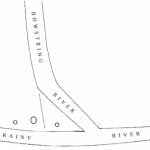
I believe our grand mound to be the earliest mound of Rainy River in the region of the Takawgamis. It is the largest in the region. It will be seen by reference to figure 3 that I arrive at its age in the following way. Where it now stands, so striking an object, it is about one-third of a mile above the point where the Bowstring River enters the Rainy River. If however from the top of the mound you look southward through the trees a view may be got of the silver stream of the Bowstring, coming as if directly toward the mound. Originally no doubt this tributary flowed close by the mound, for the mound would undoubtedly be built on the extreme point. But as from year to year the Bowstring River deposited the detritus carried down by it, it formed a bank or bar, and was gradually diverted from its course, until now, the peninsula some hundreds of yards across its base, has become upwards of a third of a mile long. I infer that this peninsula, which I should say contains some seventy acres has been formed since the mound-which from its position seems for observation as well as for sepulture-was begun. Some 200 yards down the point from the grand mound occurs another small mound. This is some eight or ten feet high, and fifty or sixty feet across. Along the point and close past this small mound runs an old water course, now a treeless hay meadow. At high water in spring, as I ascertained, the river still sends its surplus water by this old channel. My position is that the 200 yards of earth between the site of the grand mound and that of the small mound was deposited after the grand mound was begun, and before the commencement of the small mound. Undoubtedly this small mound as well as a similar one not far up the river from the grand mound, were begun on account of the laborious work of carrying bones and earth to such a height, and on account of the numerous interments which have left the surface of the grand mound a bone pile. This is shown by the small mound being on a site more recent than that of the large mound. Suppose a hundred years to have sufficed to raise the small mound to its height when the devastating ruin of the Sioux slaughtered the last mound builder and checked the mound. From our previous position this would represent a point some 500 years ago. But during this 500 years according to our hypothesis all of the point of land below the small mound, that is to say, about 300 yards in length, has been formed. The question then is, how long at the same rate must it have taken the 200 yards between the two mounds to form. This brings us then to a point say 300 years before the time of beginning of the small mound. We thus arrive at about 800 years ago as the time when the grand mound was begun. It will thus be seen that we have reached back to the eleventh century, the time previously deduced from historic date for the arrival of the Toltecans on the Rainy River.
Conclusion
Our investigation has now come to an end. I have led you to examine the few fragments of a civilization which it would be absurd to declare to have been of the very highest type, but yet of a character much above that of the wandering tribes, which, with their well-known thirst for blood, destroyed the very arts and useful habits which might have bettered their condition. The whirlwind of barbarian fury is ever one which fills peaceful nations with terror. We may remember how near in the “Agony of Canada,” the French power was to being swept out of existence by the fierce fury of the Iroquois-up to that time always victorious. We may remember how civilization in Minnesota was thrown back by the Sioux massacre of 1861. It is only now by persistent and unwearied efforts that we can hope to conquer the Indians by the arts of peace, and by inducing him to take the hoe in place of the tomahawk, to meet nature’s obstacles. Who can fail to heave a sigh for our northern mound builders, and to lament the destruction of so vast and civilized a race as the peaceful Toltecans of Mexico, of the Mississippi, and of the Ohio, to which our Takawgamis belonged? After all, their life must in the main, ever remain a mystery.
The Lost Race
“One of our visits to the mound was at night.”
Oh, silent mound! thy secret tell!
God’s acre gazing toward the sky,
‘Midst sombre shade ‘neath angel’s eye
Thou sleepest till the domesday knell.
Sweet leaflets, on the towering elms.
Oh whisper from your crested height!
Or have lost forests borne from sight
The secret to their buried realms?
Stay, babbling river, hurrying past,
Cans’t thou, who saw’st the toilers build,
Not picture on thy bosom stilled,
Life-speaking shadows long since cast?
Or, echo, mocking us with sound,
Repeat the busy voice, we pray,
Of moiling thousands, now dull clay,
And waken up the gloom profound.
Pale, shimmering ghosts that flit around,
While spade and mattock death-fields glean,
Open with words from the unseen
The mysteries now in cerements bound.
No answer yet! We gaze in vain.
With lamp and lore let science come.
Now, clear eyed maiden!!-You, too, dumb!
Your light gone out!!-’tis night again.
And is this all? an earthen pot!
A broken spear! a copper pin!
Earth’s grandest prizes counted in,
A burial mound!-the common lot!
Yes! this were all; but o’er the mound,
The stars, that fill the midnight sky,
Are eyes from Heaven that watch on high
Till domesday’s thrilling life-note sound.
